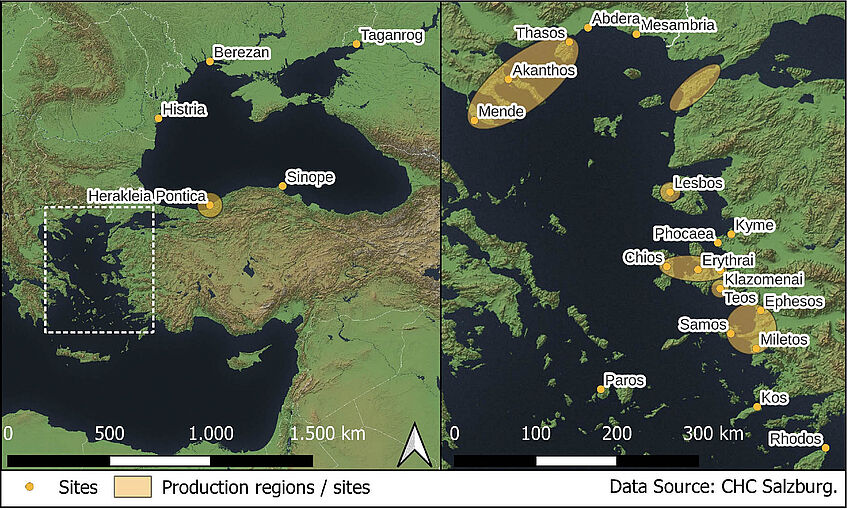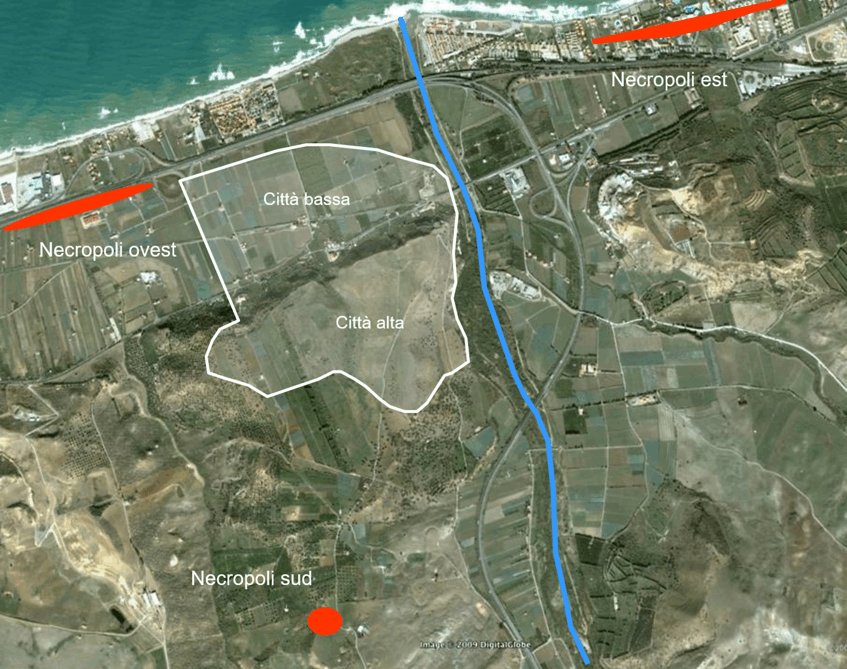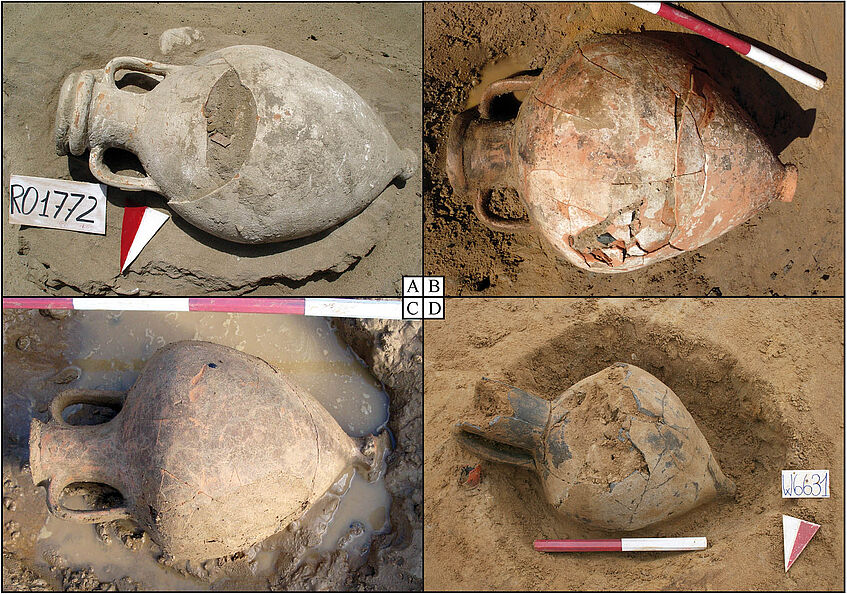Consuming the East in Sicily. The eastern Greek transport amphorae from the necropolises of Himera and new insights into the colony's extra-regional trade (mid-7th to 5th century BCE)
Project affiliation:
- Institut für Klassische Archäologie, Universität Wien
Project leader:
- Babette Bechtold (Institut für Klassische Archäologie, Universität Wien)
Co-authors:
- Stefano Vassallo (Soprintendenza BBCCAA di Palermo)
- Anno Hein (Institute of Nanoscience and Nanotechnology, Demokritos Athens)
- Ioannis Iliopoulos (Department of Geology, University of Patras)
Cooperation partners:
- Thea Summerschield (Università di Venezia Ca' Foscari): study on eastern Greek amphorae inscriptions
- Massimo Frasca (Università di Catania): research on eastern Greek amphorae found in the necropolises of Monte San Mauro
- Aurelio Burgio (Università di Palermo): research on eastern Greek amphorae found in several native sites of Himera’s hinterland
- Clemente Marconi (New York University, IFA / Università Statale di Milano): research on eastern Greek amphorae found in the major urban sanctuary of Selinunte
Staff at the ceramic lab of the University of Vienna:
- N.N.
Graphic documentation of the amphorae from Himera:
- N.N:
Financial support:
- FWF Austrian Sciences Fund, P 36827
Duration:
- September 2023 – September 2027
This project deals with provenance studies on transport amphorae, which count among the most reliable archaeological markers for economic interaction in the ancient Mediterranean.
In relation to Greek Sicily, recent research has sufficiently demonstrated that the large majority of amphorae-borne commodities consumed in the apoikiai during the 7th-5th centuries BCE had been imported from extra-regional areas. This strong dependence of the Sicilian city-states on agricultural products, most of all wine, from abroad underlines the great potential of amphora analysis for a closer screening of the island’s ‘international’ commercial networks during the Archaic and Classical-period.
The present research will focus on transport vessels produced in the Aegean basin (fig. 1), consistently documented in Sicily’s colonial and, to a certain extent, also local communities’ contexts. Despite the certainly wide-spread distribution of the class, a systematic and science-based study on these Sicilian materials is sorely lacking.
Integrating two earlier studies on Phoenician-Punic and western Greek amphorae, this investigation aims to analyse the largest ensemble of eastern Greek amphorae ever excavated in the central Mediterranean which has been re-used in enchytrismoi found in the eastern and western necropolises of Himera (fig. 2). The determination of both the fabric according to standards of FACEM and the type of c. 540 well-preserved vessels, combined with the archaeological data derived from associated grave inventories and stratigraphy (S. Vassallo) will be targeted on a diachronic classification of clearly defined series.
Petrographic studies (I. Iliopoulos) combined with pXRF and NAA chemical analyses (A. Hein), and compared with already edited data, will play a crucial role in the reliable geographic attribution of well-characterised reference groups.

Fig. 1. The Aegean and Pontic area with identified production sites/regions.
To date, only preliminary data (mainly from the eastern necropolis) on the documentation of single Aegean amphorae has been published by S. Vassallo who attributes the amphorae on stylistic grounds to the 'productions' of Samos, Chios, Lesbos and northern Greece (Thasos/Mende). The chrono-typological composition of the whole assemblage of c. 540 vessels and their provenances are unknown.

Fig. 2. Aerial view of the site of Himera with location of the necropolises (from: Bechtold, Vassallo 2018, 3, fig. 2).
However, the crucial question is: who were the major 'global players' – in terms of quantitative occurrences – among the Aegean productions (e.g. fig. 3) consumed in the Dorian-Chalcidian colony? Furthermore, can provenance studies on the corpus from Himera give evidence for the existence of different, science-based reference groups within the southern Ionian (Samos-Miletos and others?) and Lesbos-type assemblages, hinting at the – already hypothesized – activity of distinguishable workshops?

Fig. 3. A Samos-type amphora RO1772; B Ionien I.2-type amphora W1368; C Mende-type amphora W514; D Lesbos grey-type amphora W6631 (all unpublished, archive of Soprintendenza BB.CC.AA. Palermo).
Additional smaller selections of eastern Greek amphorae will be sampled in two more Greek colonies (Selinunte on the southwestern coast, e.g. fig. 4, and Monte San Mauro close to Caltagirone), in some native settlements in Himera’s hinterland (e.g. Terravecchia di Cuti), and in a few Punic sites (Carthage, Ghizène/Jerba and Cossyra/Pantelleria). This procedure will contribute to outline first regional distribution patterns of the main identified productions.
In conclusion, this project will provide multiple viewpoints for a deeper understanding of Himera’s integration into long-distance commercial trade from the second half of the 7th cent. BCE to the city’s destruction by the Carthaginians in 409 BCE. The investigation of the extraordinarily rich and well-preserved corpus of Aegean amphorae unearthed in the necropolises, integrated with smaller case studies focused on finds from colonial Sicily, the colony’s territory and some Punic sites, will set a benchmark for the chrono-typological classification of solid archaeometric reference groups attributed to regions or sites.
Finally, for Sicily, archaeological research combined with petrography and NAA chemical analyses represents an innovative approach to address multidisciplinary provenance studies on amphorae that will stand the test of time.

Fig. 4. Example of standardised documentation of a later 5th century BCE northern Aegean amphora from Selinunte, temple R (from: Bechtold 2021, 48, no. 15).
Essential references
- Bechtold, B. 2021, Le anfore da trasporto di età classica e tardoclassica dal santuario maggiore sull’acropoli di Selinunte: primi dati, in R. Ployer, D. Svoboda-Baas (eds.), Magnis Itineribus. Festschrift für Verena Gassner, Wien, 37-54.
- Bechtold, B., Vassallo, S. 2018, Le anfore puniche dalle necropoli di Himera (seconda metà del VII – fine del V sec. a.C.) (con i contributi di D. Braekmans, R. de Simone, S. Gupta, G. Montana, L. Randazzo, K. Schmidt), BABesch Suppl. Series 34.
- Bechtold, B., Vassallo, S. forthcoming, Produzioni e circolazione delle anfore greco-occidentali (VI-V sec. a.C.): il contributo dalle necropoli di Himera (con i contributi di G. Montana, L. Randazzo, T. Summerschield), BABesch Suppl. Series.
- Bîrzescu, I. 2012, Die archaischen und frühklassischen Transportamphoren (Histria XV), Bucureşti.
- Brun, J.-P. 2011, La produzione del vino in Magna Grecia e in Sicilia, in La vigna di Dioniso: vite, vino e culti in Magna Grecia. Atti del quarantanovesimo Convegno di studi sulla Magna Grecia (Taranto 2009), Taranto, 97-142.
- Buzoianu, L., Dupont, P., Lung, V. (eds.) 2013, PATABS III. Production and trade of Amphorae in the Black Sea (Constanţa 2009), Constanţa.
- Dupont, P. 1998, Archaic East Greek Trade Amphoras, in R.M. Cook, P. Dupont (eds.), East Greek pottery, London-New York, 141-191.
- Dupont, P. 2011, Données archéometriques préliminaires sur les amphores du type de Lesbos, in C. Tzochev, T. Stoyanov, A. Bozkova (eds.), PATABS II. Production and Trade of Amphorae in the Black Sea (Kiten, Nessebar, Sredetz 2007), Sofia, 171-178.
- FACEM: Gassner, V., Trapichler, M., Bechtold, B. (eds.), Provenance Studies on Pottery in the Southern Central Mediterranean from the 6th to the 2nd c. B.C., in FACEM (version 06/12/2020)
- Gassner, V. 2005, Amphoren süd- und mittelionischer Produktion in Velia, in B. Brandt, V. Gassner, S. Ladstätter (eds.), Synergia. Festschrift für Friedrich Krinzinger, Wien, 37-43.
- Geißler, L.R., Mommsen, H., Posamentir, R., Riehle, K. 2020, Ionians East and West: Differences According to Pottery Evidence, in G.R. Tsetskhladze (ed.), Ionia, West and East, part 2, 3-42.
- Georgopoulou, V., Hein, A., Grigogopoulos, D. 2018, Minding and Filling the Gaps. Exploring the Production, Technology and Trade of Koan Amphorae During the Hellenistic and Roman Periods, in Japp et al. 2018, 67-77.
- Gliozzo, E. 2020, Ceramic investigation: research questions and sampling criteria (Topical Collection on Ceramics: Research questions and answers), Archaeological and Anthropological Science 12: 202.
- Hein, A., Kilikoglou V. 2012, ceraDAT – Prototype of a web-based relational database for archaeological ceramics, Archaeometry 54, 230-243.
- Hein, A., Kilikoglou V. 2020, Ceramic raw materials. How to recognize them and locate the supply basins. Chemistry. (Topical Collection on Ceramics: Research questions and answers), Archaeological and Anthropological Science 12: 202.
- Hein, A., Dobosz, A., Day, P.M., Kilikoglou, V. 2021, Portable ED-XRF as a toll for optimizing sampling strategy: The case study of a Hellenistic amphora assemblage from Paphos (Cyprus), Journal of Archaeological Science 133.
- Huy, S., Mommsen, H., Dally, O. 2020, Herkunftsbestimmungen aus der Siedlung Taganrog am unteren Don, AA 2020,2
- Japp, S., Keweloh-Kaletta, A., Neuenfeld, N., Börker, Ch. 2018 (eds.), Amphoras in Need of Archaeology and Archaeometry (Berlin 2018), Skyllis 18,1.
- Kerschner, M., Mommsen, H. 2009, Imports of East Greek Pottery To Sicily and Sicilian Productions of East Greek Type. Archaeometric Analyses of Finds from the Votive Deposit in Katane, in A. Pautasso (ed.), Stipe votiva del Santuario di Demeter a Catania. La ceramica greco-orientale, Catania, 125-154.
- Lawall, M.L. 1995, Transport Amphoras and Trademarks: Imports to Athens and Economic Diversity in the Fifth cent. B.C. Dissertation University of Michigan.
- Lawall, M.L. 2011, Imitative Amphoras in the Greek world, Marburger Beiträger zur Antiken Handels-Wirtschafts- und Sozialgeschichte 28, 45-88.
- Lawall, M.L. 2013, Patterns in the Production and Distribution of Transport Amphoras in the 5th cent. BC: an Archaeological Perspective on Economic Change, in A. Slawisch (ed.), Handels-und Finanzgebaren in der Ägäis im 5. Jh. v. Chr. (Byzas 18), Istanbul, 103-120.
- Lawall, M.L. 2016, Transport Amphoras, Markets, and Changing Practices in the Economies of Greece, Sixth to First cent. BCE, in E.M. Harris, D.M. Lewis, M. Woolmer (eds.), The Ancient Greek Economy. Marktes, Households and City-States, Cambridge, 254-273.
- Lawall, M.L. 2017, Regional Styles of Transport Amphora. Production in the Archaic Aegean, in S. Handberg, A. Gadolou (eds.), Material Koinai in the Greek Early Iron Age and Archaic Period (Athens 2015), Aarhus, 289-314.
- Sacchetti, F. 2012, Les amphores greques dans le Nord de l’Italie. Échanges commerciaux entre les Apennins et les Alpes aux époques archaïque et classique, Aix-en-Provence.
- Santos, Y., Kondopoulou, D., Papadopoulou, L., Saridaki, N., Aidona, E., Rathossi, C., Serletis, C. 2020, An archaeometric contribution to the study of Late Classic-Hellenistic ceramics of Northern Greece. Journal of Archaeological Science: Reports, 29, 102097. doi:https://doi.org/10.1016/j.jasrep.2019.102097.
- Spagnolo, G. 2003, Anfore da trasporto nord-egee in occidente nel periodo arcaico e classico: l’esempio di Gela, in G. Fiorentini, M. Caltabiano, A. Calderone (eds.), Archeologia nel Mediterraneo. Studi in onore di Ernesto De Miro, Roma, 619-641.
- Vassallo, S. 1999, Himera, Necropoli di Pestavecchia. Un bilancio sulle anfore da trasporto, Kokalos XLV [2003], 329-379.
- Vassallo, S. 2018, Bibliografia ragionata sulle necropoli di Himera, Notiziario Archeologico della Soprintendenza di Palermo, 30/2018.
- von Miller, A.Ch.J. 2019, Archaische Siedlungsbefunde in Ephesos. Stratigraphie, Bauphasen, Keramik und Kleinfunde aus den Grabungen unter der Tetragonos Agora. Archaische Kleinfunde aus dem Theater und von den nordwestlichen Ausläufern des Panayirdaĝ (Forschungen in Ephesos XIII/3), Wien.
- Whitbread, I. 1995, Greek Transport Amphorae: A Petrographical and Archaeological Study, London.
- Whitbread, I. 2018, Petrological Analysis of Amphorae, in Japp et al. 2018, 42-49.
- Xanthopoulou, V., Iliopoulos, I., Liritzis, I. 2020, Characterization Techniques of Clays for the Archaeometric Study of Ancient Ceramics: a Review, Scientific Culture No. 6.2, 73-86.
